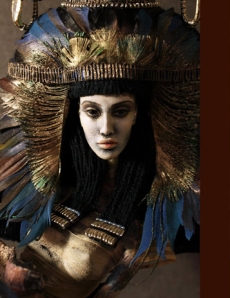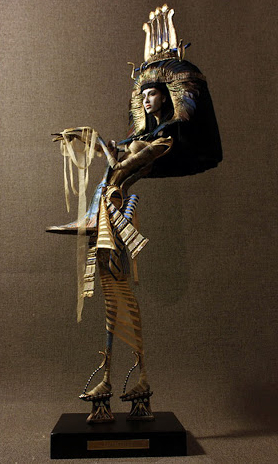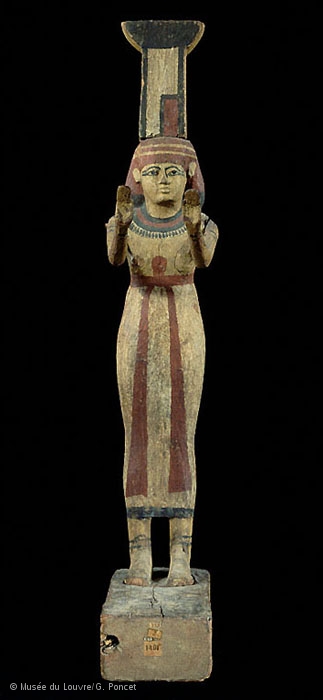Yes indeed, there is much more to say about Nephthys…
O, She is a Hidden One. In the Book of Caverns (an afterlife text), She is even described as the one Whose “head is hidden.” Yet She reveals Herself when you pay attention, when you search, when you ask.
Remember that lovely image of Nephthys by the two sister artists in last week’s post? Well, I found a couple more shots of it. Turns out the artwork is stranger and more unexpected than you would have thought having seen just the first photo.
Nephthys Herself is like that. She is stranger, more intriguing, and indeed more beautiful and powerful than you might, at first, think.
When we first read our Egyptian mythology, we see loyal Nephthys always in Her more dramatic sister’s shadow. She assists Isis with Osiris and Horus; She gets stuck with the troublesome, rowdy, and too-dry-to-be-fertile Set for a husband. As I mentioned last time, we used to think She didn’t even have Her own temples. But She did. And Her own priesthood, too.
When in a dyad with Isis, Nephthys is decidedly the “darker” one. The Pyramid Texts advise the king to “descend with Nephthys” in the Barque of the Night, but arise with Isis in the Barque of the Day. Nephthys speaks and the pathways of the Otherworld are obscured. The one being reborn is to “throw off the tresses of Nephthys” like he throws off his mummy wrappings at his rebirth. (I refer you back to a post on the magic of hair in Egyptian funerary ritual.) Nephthys is called Keku, Darkness itself. She is the Lady of the West, She is “in the Cemetery,” She is Lady of the Duat (the Underworld), Mourner and, like Her mother Nuet, She is called “Coffin.” She shares a number of these epithets with Isis (Who can be quite as dark as Her sister when She so desires).
Some researchers see Her darknesses and consider Sad-at-Heart Nephthys to be Death Itself and specifically the first half of the death process—the dying part, the entering into death part that does indeed make us sad at heart. Plutarch records that one side of the sistrum was decorated with Isis’ face while the other had Nephthys’ face, symbolizing creation and death respectively. (On Isis and Osiris, section 63)
It is an interesting and useful identification—and you can certainly make a good case for it. Yet it doesn’t quite satisfy me.
Not that Death isn’t a Big Thing. Death is possibly the Biggest Thing we face in our lives—outside of being born itself. But because it is so big, many of the Egyptian Deities are Death Deities. For instance, we could certainly consider Amentet to be Death Herself for Amentet means “The West,” that is, the Egyptian Land of the Dead and Amentet is often called the Beautiful West and welcomes the dead to Her realm.
Death is among the concerns of many Deities and it is indeed an intimate concern of Nepththys. But we’re not there yet. Where else can we look for Nephthys?
One place some scholars have looked is Her connection with other Deities. One of the more interesting ones is Her surprisingly close connection with Seshat, the Lady of Books, the Mistress of Builders.
Yeah, I know. Not the first one that would come to mind, is it?
As early as the Pyramid Texts (the oldest ones date from 2400-2300 BCE), Nephthys is said to have “collected all your members for you in this Her name of Seshat, Lady of Builders.” (Pyramid Texts, Utterance 364) Her much-later hymn from Komir invokes Her as “Seshat the Great, Mistress of Humanity, the Mistress of Writing, the Lady of the Entire Library. To You, Who utters divine decrees, Great of Magic, Who rules in the Mansion of Archivists.” There may be Isis-Nephthys parallelism in this spell from the Book of the Dead in which the deceased is seated beside the Great of Magic (possibly Isis) while Seshat (possibly Nephthys) is seated before the dead person: “Thou coolest thyself on the cedar tree beside the Great of Magic, while Seshat is seated before thee and Sia [Divine Perception] is the magical protection of thy body.” (Book of the Dead, Spell 169)
A Ptolemaic text from the Denderah temple says that Nephthys is “She who reckoneth the life-period, Lady of Years, Lady of Fate,” which Seshat does for the Pharaoh by marking notches on a palm rib. (This, of course, brings us back once again to Nephthys’ association with death.)
The Coffin Texts say, “O <name>, Horus has protected you, He has caused Nephthys to put you together, and She will put you together; She will mold you in Her name of Seshat, Mistress of Potters, for such is this great lady, a possessor of life in the Night-barque, Who raises up Horus, and She will bring to you.” (Coffin Texts, Spell 778) Texts at Edfu and Kom Ombo also record Seshat as a form of Nephthys. (However, it is well worth noting that Isis and Seshat were assimilated as well; which should remind us that, when it comes to Egyptian Deities and when it comes to spirituality, nothing is ever completely without contradiction or complication.)
The priesthoods of Nephthys and Seshat seem to have overlapped in places, too. Nephthys is married to Set and is the mother of Anubis with Osiris; interestingly, we have records of a priest of Seshat who served both Set and Anubis—and who was also in charge of “controlling the foreigners.” More on that in a minute.
The most complete discussion of Nephthys-Seshat (that’s available in English and accessible via your library, if your library is subscribed to Jstor) is in a paper by G.A. Wainwright from the 40s called “Seshat & the Pharaoh.”
He proposes that both Seshat and Nephthys were so old by the Old Kingdom that They were already starting to be forgotten and that Nephthys may have originally been rather Hathor-like, having been a Sky Goddess and a Love Goddess and a Victory Bringer (think Goddesses like Inanna and Ishtar, Who are involved in both love and war and are connected with the planet Venus). Plutarch, in the 2nd-century CE, noted that some called Nephthys Teleutê (“End”; more on that shortly), others Aphrodite, and some Nikê (“Victory”). (Plutarch, On Isis and Osiris, section 12) Nephthys got renewed life by being brought into the Isis-Osiris cycle, while Seshat came into the counting house of pharaoh and became connected with Thoth.
A Nephthys-Seshat connection that doesn’t seem to have been made by anyone I’ve read so far jumped out at me. So…speculation alert; here we go.
As Lady of Builders, one of Seshat’s main functions is to lay out the boundaries for new buildings, especially temples, via the ceremony of “stretching the cord,” which was a method of using a cord or rope to measure out straight foundations for a building. She is Goddess of architecture, math, and accounting, as well as being the Divine Scribe. Broadly, these are concerns of delineation, creating limits, setting boundaries, deciding what is in and what is out. Keep that in mind as we go on to the next part.
Next, let’s look at Nephthys’ name. In Egyptian, it’s Nebet-Hwt, the Lady (Nebet) of the Temple (Hwt). You will also see it as Lady of the House. “House” is one translation of hwt, but that translation has, for most of us at least, connotations of the home or household—but Nephthys has little in Her of Hestia or Vesta. More usually, hwt means a mansion, temple, or even tomb. (Remember those similar meanings for Isis’ name?)
The hieroglyph for Nephthys’ name combines two other symbols: a neb bowl placed on top of the hwt sign, which is a rectangular sign with a little square or rectangle in the lower right. The neb glyph represents a wickerwork basket and conveys concepts such as “lord” (neb) or “lady” (nebet with the feminine t ending) and “all” or “every.” My guess is that because neb meant “all” it was also used to refer to the ruler of all, the lord or lady. Gardiner (Egyptian Grammer) says the hwt glyph is an “enclosure seen in plan,” in other words, we’re sort of looking down at a blueprint for a building.
What better name glyph for the Lady of Builders than one that represents the blueprint of a building? The Lady of the House—the Goddess with a blueprint in Her name—is also the architecture Goddess Who delineates the foundations of all buildings—but especially the sacred houses of the Deities, the temples.
At Denderah, we even find an ibis-headed Nephthys, which only strengthens the connection between Nephthys and the Divine Scribe, this time with the Divine Male Scribe (Sesh), Thoth, rather than the Divine Female Scribe, Seshat.

Now, let’s go back to Plutarch’s comments about what people in his time called Nephthys: Teleutê. In Greek, it means ending or completion. Plutarch says, “They give the name Nephthys to the ends of the earth and the regions fringing on mountains and bordering the sea. For this reason, they call Her Teleutê and say She cohabits with Typhon [Set].” (On Isis and Osiris, section 38) Later he says that Nephthys is what is “below the earth and invisible” in contrast with Isis Who “is above the earth and manifest.” (On Isis and Osiris, section 44) Both statements speak of Nephthy’s mystery and liminality. She is the border between here and there, then and now, in and out. And if She is that border, She also controls it. The priest of Seshat mentioned earlier was also “controller of the foreigners” and Nephthys’ husband Set is God of foreigners and foreign lands; thus the Goddess and God delineate or “draw the line” between us and The Other.
An Egyptian epithet of Nephthys calls Her Nebet-er-djer Em Em Netjeru, which Tamara Suida translates as “Lady to the Limit Under the Gods.” (Thank you, Tamara for your booklet on Nebt-hwt…and most especially those epithets.) There’s also a God called Neb-er-djer, which I’ve seen translated as Lord to/of the End or Lord to/of the Utmost, so we may also translate this Nephthys epithet as Lady of the End (Teluetê again!) or Lady to the Utmost Em Em (“among”) the Deities. Here again, Nephthys is the border, the line, the limit between “all of this” and whatever is beyond the End, the Limit, the Utmost.
As you probably figured out, djer in Egyptian is “end” or “limit.” Faulkner (Middle Egyptian) thinks djeri may mean an enclosing wall, a djeru is indeed a boundary, and the djerty are the Two Kites, Isis and Nephthys. This last, the Djerty, may mean nothing other than being an interesting coincidence. On the other hand, perhaps we can think of the Two Djerty circling aloft, delineating a space in the heavens—one that may be reflected on earth, for example, as They protectively encircle the body of Osiris as He awaits rebirth.
Now let us come back once more to the Lady of the Temple. What are temple walls but the boundary and the limit between sacred and profane? Thus it is Nephthys, the Lady of the Temple, Who founds and builds the temple walls, enclosing the sacred within, setting it aside as special, protected, and preserved.
Whew! I’m stopping now. I think I’ve must have worn us both out for today. I’ll have more to say about Her sometime soon. For instance, there is some doubt about that whole “adultery with Osiris” thing. We shall see.
Amma, Nebet-hwt.










